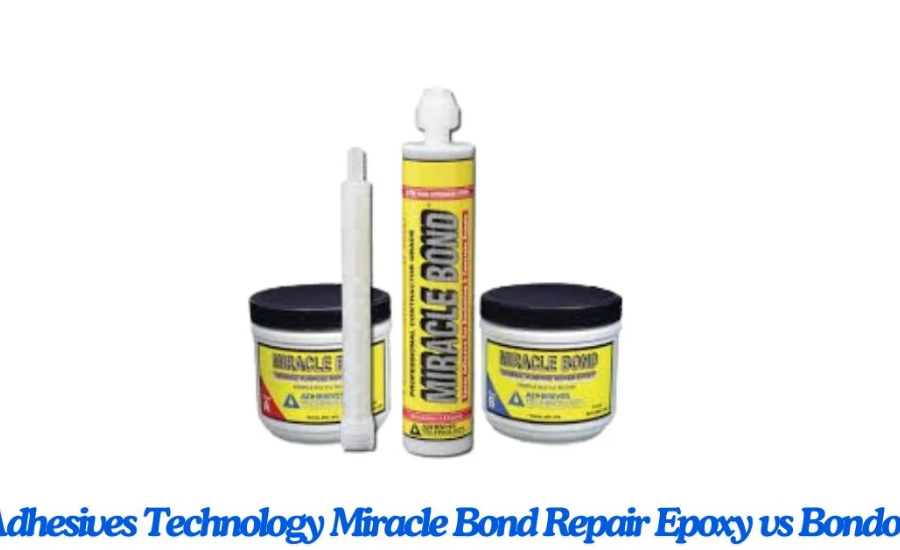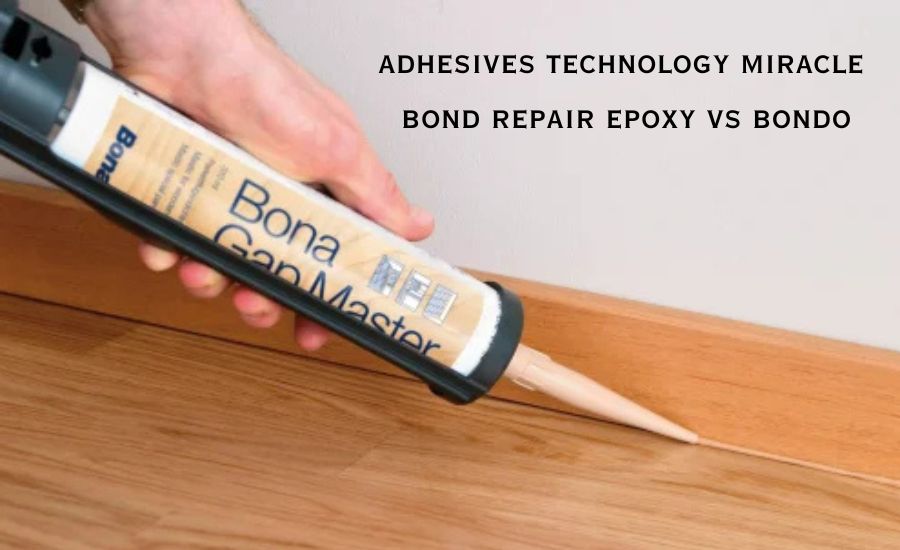In the realm of Adhesives Technology Miracle Bond Repair Epoxy vs Bondo Bond repair epoxy and Bondo are popular options for repairing materials like wood, metal, and plastic. Knowing the differences between these adhesives can help in choosing the right one for specific projects.
Miracle Bond is a two-part epoxy, consisting of a resin and a hardener, that forms a durable, high-strength bond ideal for heavy-duty repairs. This makes it especially effective for tasks requiring lasting support. Bondo, on the other hand, is widely used in auto body repairs. Also a two-part system, Bondo functions primarily as a filler to address dents and scratches on vehicles. Each product offers unique benefits, excelling in different types of repair situations.
Understanding Adhesives Technology: A Guide To Modern Bonding Solutions

Adhesives technology involves using specialized substances to bond materials together, playing a vital role in fields such as construction, arts, and everyday repairs. With various options available, understanding adhesives like Miracle Bond repair epoxy and Bondo can help in selecting the best product for specific needs.
Miracle Bond repair epoxy is particularly popular for its strength and durability. Composed of a resin and a hardener, this two-part system forms a reliable bond when mixed, making it well-suited for projects involving heavy materials and challenging conditions. When comparing Miracle Bond epoxy to Bondo, understanding their applications and strengths enables you to make an informed decision based on your project requirements.
Key Features Of Miracle Bond Repair Epoxy
- High Strength and Adaptability:
- Recognized for its robust performance, flexibility, and durability.
- Works effectively across multiple surfaces, including metal, wood, ceramic, and plastic.
- A reliable solution for both heavy-duty household fixes and industrial repairs.
- Innovative Two-Part System:
- Consists of a unique resin and hardener formula.
- Activates a powerful, lasting bond when mixed.
- Capable of supporting significant stress and weight, suitable for demanding applications.
- Fast Curing Advantage:
- Designed to set quickly, enabling faster project turnaround.
- Ideal for quick-fix scenarios without sacrificing strength or reliability.
- Weather-Resistant Durability:
- Suitable for both interior and exterior projects.
- Maintains a secure bond even in humid or variable weather conditions.
- Perfect for outdoor repairs like garden furniture or tools.
- Preferred by DIY Enthusiasts:
- A top choice when compared to alternatives like Bondo for its superior durability and adaptability.
- Highly valued by those looking for a dependable, high-performing adhesive for versatile applications.
What Is Bondo?
Bondo in Adhesives Technology Miracle Bond Repair Epoxy vs Bondo is a widely recognized brand, particularly in the automotive sector, where it is primarily used for car body repairs. This versatile product serves as both a filler and an adhesive, making it a popular choice among DIY enthusiasts and professionals alike. Bondo is available as a two-part system, consisting of a resin and a hardener. When these components are combined, they create a robust bond that can effectively withstand impacts and vibrations, which is essential for automotive applications.
One of the key reasons for Bondo’s popularity is its user-friendly nature. Its paste-like consistency facilitates easy application and filling of gaps, allowing users to work efficiently. After the application, Bondo can be sanded down to achieve a smooth, even surface. Once fully cured, it can also be painted over to seamlessly blend with the surrounding area, enhancing its aesthetic appeal. These features make Bondo a top choice for automotive repairs and a significant player in the discussion of adhesive technologies, particularly when comparing it to alternatives like Miracle Bond Repair Epoxy.
Important Features Of Bondo
Bondo offers several distinctive features that contribute to its reputation as a dependable repair solution. One of its standout qualities is its durability. Engineered to withstand the rigors of everyday use, Bondo is tough enough to effectively address dents, scratches, and various forms of damage commonly found in automotive contexts. This reliability makes it a preferred option for automotive repairs, particularly when evaluating it against alternatives like Miracle Bond Repair Epoxy.
Another noteworthy attribute of Bondo is its versatility. Although primarily designed for automotive applications, it can also be used on wood and other materials, providing a flexible solution for a wide range of repair projects around the home. Additionally, Bondo is paintable. After it cures, it can be easily coated with paint, allowing users to match it seamlessly with the surrounding surface. These essential features position Bondo as a strong contender in discussions about adhesive technologies, particularly when comparing it with Miracle Bond Repair Epoxy.
Comparing Adhesives Technology Miracle Bond Repair Epoxy vs Bondo: Key Differences

Purpose and Bonding Strength:
- Miracle Bond: Engineered to create strong bonds across various materials, including metal, wood, and ceramics, making it highly effective for projects requiring a secure, durable hold that can withstand significant stress.
- Bondo: Primarily acts as a filler, designed to smooth surfaces and repair cosmetic flaws, such as dents. Often used in auto body repairs, it excels at filling gaps and creating a sandable, paint-ready finish but lacks the bonding strength needed for heavy-duty applications.
Curing Duration:
- Miracle Bond: Features a quick curing time, reaching full strength within minutes, ideal for repairs requiring fast results without sacrificing durability.
- Bondo: Requires a longer curing period, offering ample time for sanding and painting but is less suited for applications where immediate strength is crucial.
Moisture Resistance:
- Miracle Bond: Highly resistant to water, making it a reliable choice for outdoor repairs or applications exposed to damp environments.
- Bondo: Provides moderate moisture resistance, making it better suited for indoor repairs where water exposure is minimal.
Optimal Use Cases:
- Miracle Bond: Suitable for both home and industrial repairs where a robust bond and high stress tolerance are essential.
- Bondo: Perfect for auto body repairs and projects needing a smooth, paintable surface rather than heavy-duty adhesion.
Best Conditions for Application:
- Miracle Bond: Adaptable across various materials and durable in outdoor conditions, making it versatile for a range of repair needs.
- Bondo: Best applied for interior, surface-level repairs where minimal exposure to moisture is anticipated.
Evaluating Cost-Effectiveness
When it comes to cost-effectiveness, both Miracle Bond Repair Epoxy and Bondo present different pricing structures along with unique advantages. Miracle Bond tends to have a higher initial cost; however, its exceptional durability can lead to savings over time by reducing the need for frequent repairs or replacements.
In contrast, Bondo is often viewed as a more economical choice, appealing to DIY enthusiasts seeking quick, budget-friendly solutions. It is widely available and ideal for temporary fixes. Nevertheless, users should consider that Bondo may necessitate additional applications or finishing touches over time, which could add to the overall expense.
To make the most economical decision, assess the specific requirements of your project. Consider how often you plan to use these products and whether the long-term benefits of durability justify the higher upfront investment. A bit of planning and research can result in smarter spending on repairs and replacements in the future.
Ideal Applications For Miracle Bond Repair Epoxy And Bondo
Miracle Bond Repair Epoxy is particularly well-suited for situations that demand high strength and waterproof characteristics. It excels at bonding a variety of materials, including metal, wood, ceramics, and plastics. This makes it an excellent choice for robust repairs around the home, as well as for crafting projects that require a reliable and durable bond.
In contrast, Bondo is a go-to option for automotive applications. Its rapid-drying formula is designed for bodywork repairs on vehicles, making it ideal for tasks such as filling dents and achieving a smooth surface finish. Bondo’s effectiveness shines in scenarios where cosmetic appearance is critical, particularly in automotive contexts.
For DIY enthusiasts engaged in furniture restoration, both products offer valuable solutions. Miracle Bond is perfect for mending broken chairs or tables, ensuring structural integrity, while Bondo provides an exceptional finish for refinishing surfaces, allowing for aesthetically pleasing results. Each product has its strengths, making them useful tools in any repair toolkit.
How To Apply Miracle Bond And Bondo
Applying both Miracle Bond and Bondo is a simple process, though each has its own specific steps.
For Miracle Bond, start by thoroughly mixing the resin and hardener in the recommended proportions. It’s crucial to combine them completely to ensure optimal bonding performance. After mixing, apply the epoxy to the area needing repair, ensuring even coverage.One of Miracle Bond’s key advantages is its quick-setting time, making it ideal for projects requiring fast repairs.
Bondo, on the other hand, follows a similar mixing process where you combine the resin and hardener. Using a putty knife, you can then apply the mixture directly to the damaged area. Its paste-like consistency makes it easy to fill in gaps and achieve a smooth finish. Once Bondo has cured, you can sand it down to create an even surface and paint over it if desired.
Both Miracle Bond and Bondo are designed for user-friendly application, making them suitable choices in discussions about adhesive technologies and repair solutions. Whether you need a fast bond or a smooth surface repair, each product offers distinct advantages to meet various project needs.
Choosing Between Miracle Bond And Bondo

Selecting the right product between Miracle Bond and Bondo hinges on the specific requirements of your project. Miracle Bond is an excellent choice if you’re looking for a versatile adhesive that works well with a variety of materials. Known for its strong bonding capabilities, rapid setting time, and impressive moisture resistance, Miracle Bond excels in numerous applications, making it a top contender for general repair tasks.
On the other hand, if your focus is primarily on automotive repairs, Bondo may be more appropriate. This product is formulated specifically for use on car bodies and similar applications, making it ideal for fixing dents and imperfections in vehicles. Understanding the distinct characteristics of these adhesives is essential for making an informed decision.
Ultimately, evaluating your project’s specific needs will guide you in choosing between Miracle Bond and Bondo. Knowing what you require from an adhesive—whether it’s versatility for various materials or specialized automotive repair capabilities—will help you select the most effective option for your task.
Customer Reviews And Experiences
Customer feedback provides essential insights into the practical performance of Adhesives Technology Miracle Bond Repair Epoxy vs Bondo. Users often commend Miracle Bond for its ability to create strong, durable bonds across a range of materials. Its fast curing time is particularly appreciated, enabling users to complete their repairs swiftly.
Conversely, Bondo is frequently lauded for its versatility and the ease with which it can be sanded after curing. Many customers favor it for automotive projects due to its smooth finish, which paints over seamlessly.
While some users mention that Miracle Bond can present a steeper learning curve initially, they often find the results rewarding once they become proficient. In contrast, many Bondo users highlight its straightforward application process, making it a user-friendly option, especially for beginners.
Overall, real-world experiences show that both products have unique strengths tailored to different needs and projects. Ultimately, the decision between them depends on individual preferences and the specific requirements of the task at hand.
FAQs
1. What is the primary difference between Miracle Bond Repair Epoxy and Bondo?
Miracle Bond Repair Epoxy is designed for creating strong, long-lasting bonds across various materials and is known for its durability and moisture resistance. Bondo, on the other hand, is primarily a filler used for smoothing surfaces and is favored for automotive applications.
2. How long does it take for Miracle Bond and Bondo to cure?
Miracle Bond typically cures quickly, often reaching full strength within minutes, making it suitable for time-sensitive repairs. Bondo takes longer to cure, which allows for sanding and finishing but may not be ideal for immediate repairs.
3. Can I use Miracle Bond on automotive projects?
Yes, Miracle Bond can be used for automotive projects, but Bondo is specifically formulated for such applications, making it a preferred choice for bodywork and surface repairs.
4. Is Bondo suitable for outdoor use?
Bondo offers moderate moisture resistance but is generally better suited for indoor applications where exposure to harsh weather conditions is limited.
5. Are both products easy to use for DIY projects?
Yes, both Miracle Bond and Bondo are user-friendly. Miracle Bond requires careful mixing of resin and hardener, while Bondo’s paste-like consistency allows for easy application and filling of gaps.
6. Which product is more cost-effective?
Miracle Bond has a higher initial cost but offers exceptional durability, potentially saving money in the long run. Bondo is more budget-friendly, making it a popular choice for quick fixes, though it may require additional applications over time.
Conclusion
When choosing between Adhesives Technology Miracle Bond Repair Epoxy vs Bondo, it’s essential to consider your specific project needs. Miracle Bond excels in creating strong, resilient bonds, making it ideal for demanding repairs across various materials. Its quick curing time and chemical resistance make it a go-to choice for heavy-duty applications.
Conversely, Bondo is favored for its versatility, especially in automotive repairs, where a smooth finish is crucial. Its ease of application and paintability make it a favorite among DIY enthusiasts.
Ultimately, the best choice hinges on the requirements of your project—whether you prioritize durability and strength or ease of use and surface finishing. By understanding the unique strengths of each product, you can make an informed decision that aligns with your repair needs.
Keep up-to-date with breaking news and updates on Americanews





